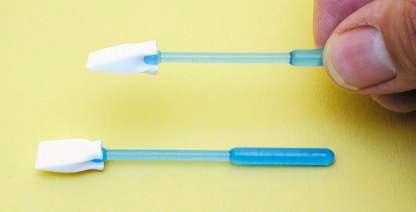The diamond and sapphire knife cleaning tools (Product No. 122-10, 122-20) are specially developed for cleaning debris from diamond knives. It also works on sapphire knives, scalpel blades, microtome blades, Vibratome blades, diamond scribers, and minitools.
Safe Cleaning Tool
The PVA sponge wicks away liquid immediately, making it a safe cleaning tool, better than wooden sticks and other cleaning tools. This may be reused many times.
Since PVA does not expand in alcohol, it can be dipped in reagent alcohol and used in the rigid form. It can also be expanded first by dipping in water and then in reagent alcohol, after the PVA has been left to dry and stiffen. Dipping in alcohol after immersion in water can reduce the time required for it to dry and stiffen.
Types of PVA Sponge
Two types are available:
- Wedged tip on a plastic holder (pk/20) for safest use
- Block with rounded ends (pk/5) 1-1/2 x 3/4 x 1/2" (38 x 18 x 13 mm)

122-10 Cleaning Tool
The diamond or sapphire knife is made of a single crystal. Its edge is uniform and sharp because it is very hard and has a regular crystal structure.
Guidelines to Follow
However, this also makes the edge thin and fragile. Hence, to ensure it has a long life, no solid objects should touch the edge. Some guidelines to follow:
- When removing or inserting the knife, the edge should not be touched.
- During microtome operation, tools should not touch the edge.
- The blade should be safely stored in the box when not in use.
Good quality sections are made in clean environments. Knives can be kept clean by:
- Using clean water, buffer, or reagents in the microtome.
- Wiping and rinsing the reservoir and stage of the microtome between use.
- Not allowing sections to dry on the knife.
One cause of sectioning problems, especially knife marks, may be a dirty knife. The knife edge can be cleaned using the Diamond Knife Cleaning Tools, Product No. 122-10 or 122-20 using the following steps:
- The PVA sponge material should be wetted with clean water and if needed, dried to obtain the desired shape and stiffness.
- The PVA sponge should be dipped in reagent alcohol.
- The tip of the PVA sponge is dragged gently along the side of the knife, parallel to the edge.
- The same procedure is repeated on the other side of the blade and is allowed to air dry.
An alternate procedure follows that is done when viewing the knife edge under a dissecting microscope.
- The PVA sponge is wetted with clean water, dipped in reagent alcohol, and dried to achieve the required shape and stiffness.
- The expanded and dried PVA sponge is dipped in reagent alcohol and the excess removed by shaking or blotting on filter paper.
- The PVA sponge is pressed against the edge of the knife as if to split the tip.
- The spear tip is wiped parallel to the cutting edge, never obliquely or perpendicularly, and moved across the entire length of the knife edge.
- Using a fresh part of the spear, the same process is repeated in the opposite direction and allowed to air dry.

This information has been sourced, reviewed and adapted from materials provided by Ted Pella, Inc.
For more information on this source, please visit Ted Pella, Inc.